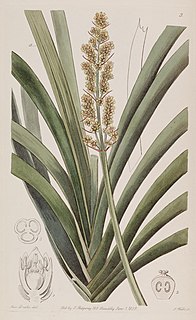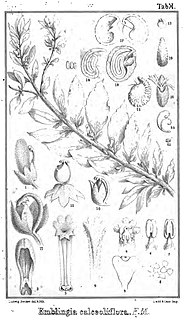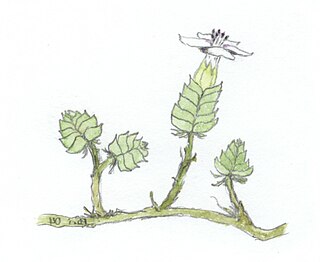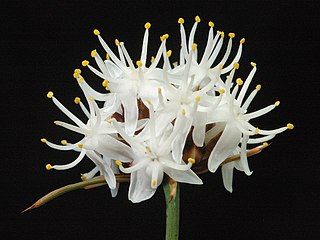
Southwest Australia is a biogeographic region in Western Australia. It includes the Mediterranean-climate area of southwestern Australia, which is home to a diverse and distinctive flora and fauna.

Lomandra, commonly known as mat rushes, is a genus of perennial, herbaceous monocots in the family Asparagaceae, subfamily Lomandroideae. There are 51 species, all of which are native to Australia; two of them also extend into New Guinea and New Caledonia.

Emblingia is a monospecific plant genus containing the species Emblingia calceoliflora, a herbaceous prostrate subshrub endemic to Western Australia. It has no close relatives, and is now generally placed alone in family Emblingiaceae.

Livistona mariae, also known as the central Australian or red cabbage palm, is a species of flowering plant in the family Arecaceae.

Lomandra longifolia, commonly known as spiny-head mat-rush, spiky-headed mat-rush or basket grass, is a perennial, rhizomatous herb found throughout eastern Australia. The leaves are 40 cm to 80 cm long, and generally have a leaf of about 8 mm to 12 mm wide. It grows in a variety of soil types and is frost, heat and drought tolerant. Labillardiere described Lomandra longifolia from a specimen collected in Tasmania.
Minuria is a genus of annuals, perennials and dwarf shrubs in the aster tribe within the sunflower family.

Wilsonia humilis, the silky wilsonia, is a species of perennial subshrub in the family Convolvulaceae. The species is endemic to Australia, occurring in coastal saltmarshes and also occasionally in inland saline areas, often colonising bare ground.

Lomandra obliqua, known as fish bones and twisted mat-rush, is a small wiry ground covering plant found in eastern Australia. A widespread plant seen on the coast and tablelands. The foliage superficially resembles a fern, but creamy/yellow flowers form on clusters in spring. Leaves are two ranked, somewhat glaucous and twisted.

Cryptostylis hunteriana, commonly known as the leafless tongue-orchid is a flowering plant in the orchid family Orchidaceae and is endemic to south eastern Australia. It is leafless but has up to ten green flowers with a more or less erect, dark reddish brown labellum.
Dipodium campanulatum, commonly known as the bell-flower hyacinth orchid, is a leafless mycoheterotroph orchid that is endemic to south-eastern Australia. In summer it has up to thirty five white flowers with large, dark red spots and blotches.

Lomandra hystrix, commonly known as green mat-rush, or creek mat-rush, is a perennial, rhizomatous herb found throughout eastern Australia.

Patersonia sericea, commonly known as the purple flag, native iris, silky purple flag or native flag is a species of plant in the iris family Iridaceae which is endemic to eastern Australia. It is relatively easy to cultivate, and even the type specimen provided to the taxonomist, Robert Brown was "...furnished us by Messrs. Lee and Kennedy, of Hammersmith, West London who received the seeds, from which they raised it, from Port Jackson".

Acacia auratiflora, commonly known as the orange-flowered wattle, is a shrub of the genus Acacia and the subgenus Plurinerves. It is listed as an endangered species.
Platysace compressa, commonly known as the tapeworm plant, is a perennial herb that is endemic to Western Australia.
Caladenia conferta, commonly known as the crowded spider orchid or coast spider-orchid, is a plant in the orchid family Orchidaceae and is endemic to a restricted area in South Australia. It is a ground orchid with a single hairy leaf, and usually a single yellowish-green flower with red markings on a wiry, hairy stalk.
Caladenia rigida, commonly known as the stiff spider orchid, or white spider-orchid is a plant in the orchid family Orchidaceae and is endemic to South Australia. It is a ground orchid with a single hairy leaf and one or two white flowers with dark glandular tips on the sepals and fine reddish-brown lines along the sepals and petals.
Caladenia saggicola, commonly known as the sagg spider orchid, is a species of orchid endemic to Tasmania. It has a single erect, hairy leaf and one or two white flowers with very pale reddish lines and black tips.
Lomandra effusa is a perennial, rhizomatous herb found in Australia.

Lepidosperma squamatum is a species of flowering plant in the sedge family, Cyperaceae. It is native to Southwest Australia. It was described by Jacques Labillardière in Novae Hollandiae Plantarum Specimen (1805). The specific epithet squamatum is derived from the Latin for 'scale', in reference to the form of the bracts.

Borya sphaerocephala is a perennial herbaceous plant found in southwest Australia. A common name for the species is pincushions. The height is 20–200 millimetres, White flowers appear between August and October. The species is associated with the region's granite outcrops, occurring in depressions and seasonally wet areas, growing in crevices and at the edge of moss mats. As a resurrection plant it is able to withstand seasonal dehydration of its environ. The species was first described by Robert Brown, published in his 1810 work on Australian plants. A combination Baumgartenia sphaerocephala, currently regarded as synonym, was published by Kurt Sprengel several years after Brown.












